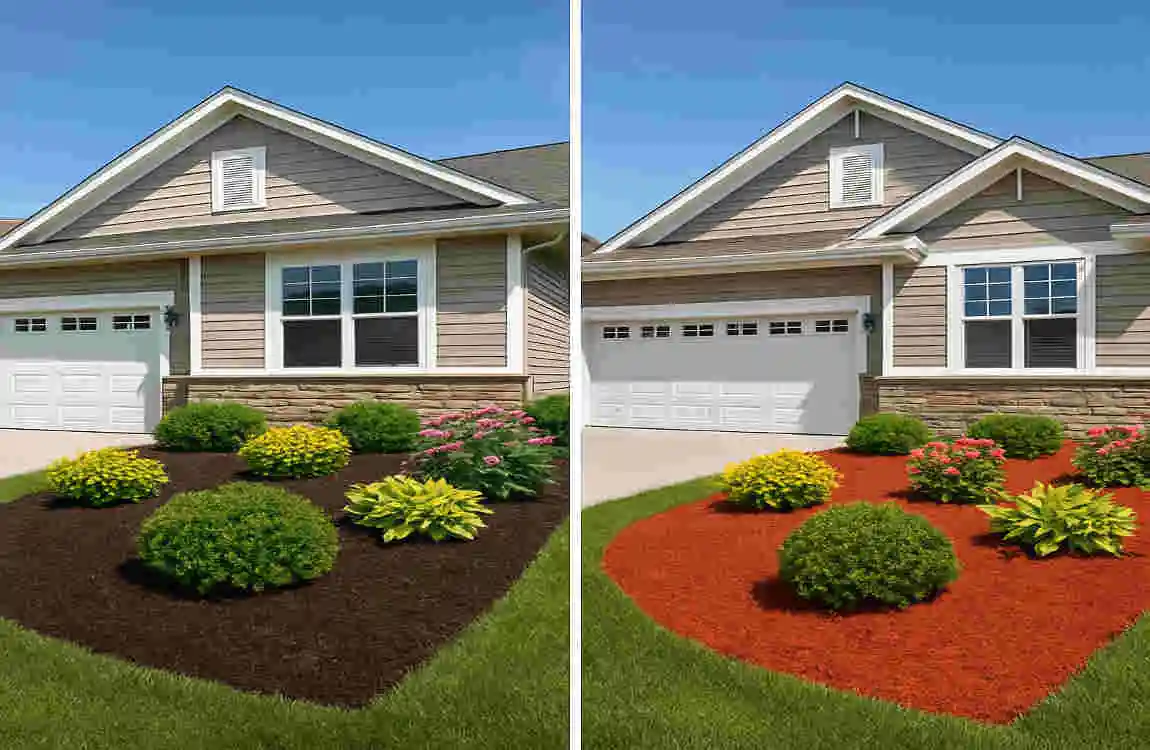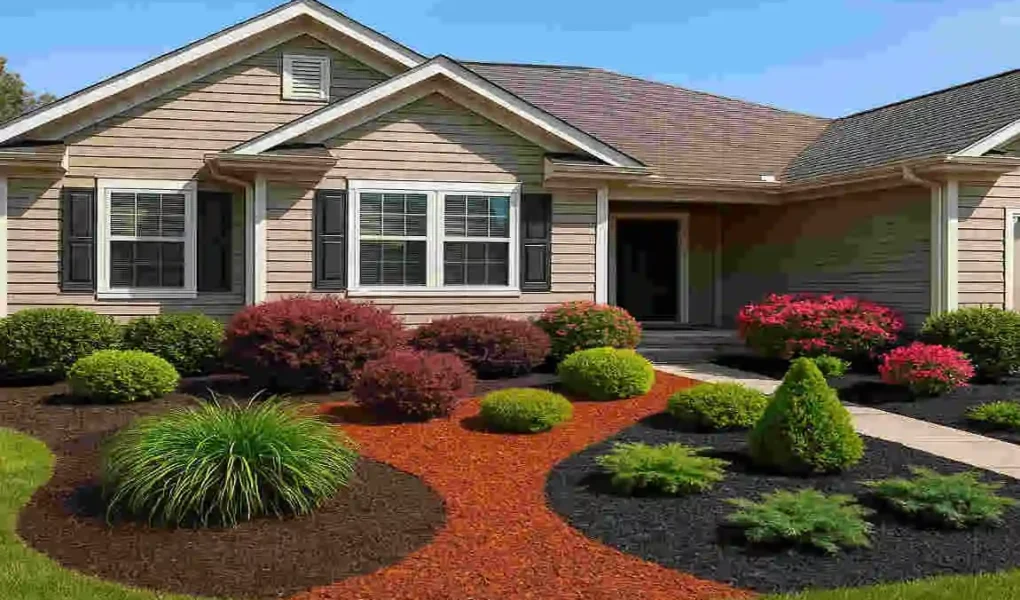Have you ever driven through a neighborhood and noticed how some homes seem to pop while others blend into the background? The secret often lies in the landscaping details, and believe it or not, mulch color plays a starring role in your home’s curb appeal. If you’re wondering what color mulch for tan house exteriors works best, you’ve come to the right place.
Your home’s exterior is like a canvas, and the mulch you choose acts as the frame that either enhances or diminishes the overall picture. Tan homes, with their warm and inviting neutral tones, offer incredible flexibility when it comes to landscaping choices. However, this flexibility can also make the decision-making process feel overwhelming.
Think about it this way: your mulch isn’t just a practical ground covering that helps your plants thrive. It’s a design element that can transform your property from ordinary to extraordinary. The right mulch color can highlight your home’s architectural features, complement your garden’s plant palette, and create visual harmony that makes your property stand out for all the right reasons.
Understanding Mulch and Its Benefits
Before we dive into color selection, let’s start with the basics. What exactly is mulch, and why should you care about it beyond its aesthetic appeal?
Mulch is any material spread over the surface of soil to protect and enhance your garden beds. It comes in two main categories: organic and inorganic. Organic mulches include wood chips, bark, straw, and compost materials that decompose over time. Inorganic options encompass rubber mulch, stones, and landscape fabric that don’t break down.
The beauty of mulch extends far beyond its visual appeal. It’s a multitasking garden hero that works tirelessly to improve your landscape’s health and appearance. When you spread mulch around your plants, you’re creating a protective barrier that locks in soil moisture. This means less frequent watering for you and happier, healthier plants that can withstand dry spells better.
Weed control is another superpower of mulch. By blocking sunlight from reaching weed seeds, a good layer of mulch dramatically reduces the time you’ll spend pulling unwanted plants. It’s like having a natural weed barrier that also happens to look great.
Temperature regulation might not be the first thing you think about, but it’s crucial for plant health. Mulch acts like insulation for your soil, keeping it cooler in scorching summers and warmer during chilly winters. This temperature stability helps protect plant roots from extreme weather conditions.
But here’s where it gets really interesting for homeowners focused on aesthetics: mulch is a design tool. The color and texture you choose can completely transform the visual impact of your landscape. It creates clean lines between lawn and garden beds, provides a unified backdrop for your plants, and ties together different elements of your outdoor space.
When you’re considering what color mulch for tan house exteriors works best, you’re choosing the finishing touch that brings your entire landscape design together. It’s the detail that can make your property look professionally landscaped, even if you’re doing it yourself.
Overview of Tan Homes: Color Characteristics and Style
Tan is more than just a color – it’s a design choice that speaks volumes about your home’s character. This warm, neutral hue has become increasingly popular among homeowners, and for good reason. It offers versatility that few other exterior colors can match.
When we talk about tan homes, we’re actually discussing a rich spectrum of shades. From light sandy beiges to deeper caramel tones, tan encompasses warm undertones that can lean slightly yellow, pink, or even gray. This variety means that no two tan homes are exactly alike, which is why mulch selection requires careful consideration.
Popular trim colors that accompany tan exteriors often include crisp whites, deep browns, or even bold blacks for a more contemporary look. Some homeowners opt for cream or ivory trim for a softer, more monochromatic appearance. These trim choices significantly impact which mulch colors will work best for your landscape.
Tan homes fit beautifully into various architectural styles. You’ll find this versatile color gracing everything from cozy Craftsman bungalows to sprawling Ranch-style homes. Mediterranean-inspired villas often feature tan stucco exteriors, while modern farmhouses use tan siding to create that perfect blend of contemporary and traditional aesthetics.
The neutral nature of tan is both its greatest strength and its most significant challenge. While it provides an excellent backdrop for landscaping creativity, it also demands thoughtful accent choices. Without the correct complementary elements, a tan home can appear washed out or bland.
This is where your landscaping – and specifically your mulch choice – becomes crucial. Tan homes need balanced accents that add visual interest without overwhelming the subtle beauty of the neutral palette. The right mulch color can provide just enough contrast to define your garden beds while maintaining the sophisticated, welcoming appearance that tan homes are known for.
Consider your tan home as a blank canvas waiting for artistic touches. The mulch you choose will serve as one of the primary ways to add depth, dimension, and personality to your property’s overall appearance.
What Color Mulch Works Best for Tan Houses?
Now we arrive at the heart of the matter: what color mulch for tan house exteriors creates the most stunning visual impact? The answer isn’t one-size-fits-all, but specific colors consistently deliver exceptional results.
Dark Brown Mulch: The Classic Choice
Dark brown mulch stands out as the most popular option for tan homes, and it’s easy to see why. This rich, chocolate-colored mulch creates a striking contrast against tan siding without being too dramatic. It mimics the natural color of soil and aged wood, providing an organic feel that complements any garden style.
The beauty of dark brown mulch lies in its ability to define planting beds clearly. Against a tan backdrop, it creates visual boundaries that make your landscaping look intentional and well-maintained. Plants seem to pop against the dark background, and the overall effect is both sophisticated and natural.
Red Mulch: Adding Warmth and Vibrancy
For homeowners who want to inject some personality into their landscape, red mulch offers an exciting option. This warm-toned mulch picks up on the subtle undertones often found in tan paint colors, creating a harmonious color story that feels cohesive rather than jarring.
Red mulch works particularly well with tan homes that have warm, peachy, or golden undertones. It adds vibrancy without overwhelming the neutral palette, and it pairs beautifully with green foliage. The result is a landscape that feels alive and energetic, yet maintains sophistication.
Black Mulch: Modern Sophistication
Black mulch has gained popularity in recent years, especially among homeowners seeking a contemporary aesthetic. Against tan siding, black mulch creates the highest level of contrast, resulting in a dramatic, modern look that makes a statement.
This bold choice works exceptionally well with tan homes featuring black or dark gray trim. It creates a cohesive color scheme that ties the landscape to the home’s architectural elements, creating a harmonious visual connection. Black mulch also has the advantage of making colorful flowers and green plants appear more vibrant by comparison.
Natural Wood Mulch: Subtle Elegance
Sometimes, less is more. Natural or light-colored wood mulch provides minimal contrast against tan homes, creating a soft, subtle aesthetic that appeals to those who prefer understated elegance. This option works beautifully for cottage-style gardens or landscapes designed to look effortlessly natural.
Light wood mulch allows other landscape elements to take center stage. It’s perfect if you have spectacular plantings or architectural features you want to highlight without competition from bold mulch colors.
Colors to Avoid
While exploring what color mulch for tan house exteriors works best, it’s equally important to know what to avoid. Bright orange or yellow mulches often clash with the subtle warmth of tan. Similarly, mulches with blue or purple tones can create an unnatural appearance that detracts from your home’s appeal.
Matching Mulch Colors to Landscaping Styles and Plant Choices
Your mulch color choice shouldn’t exist in isolation. It needs to work harmoniously with your entire landscape design, including your plant selections and overall garden style.
Consider the color wheel of your garden. If you have beds filled with cool-toned purple and blue flowers, a warm red mulch might create visual discord. Instead, dark brown or black mulch would provide a neutral backdrop that lets these colors shine. Conversely, gardens featuring warm-toned flowers in reds, oranges, and yellows can handle the additional warmth of red mulch beautifully.
Shrubs and evergreens present another consideration. These permanent fixtures in your landscape will interact with your mulch color year-round. Dark mulch colors tend to make green foliage appear more vibrant, while lighter mulches create a softer overall appearance.
Think about using mulch color to create focal points in your landscape. You might use black mulch in your front beds to create drama and draw the eye, while using natural wood mulch in side gardens for a more relaxed feel. This strategic use of color can guide visitors’ attention and create visual interest throughout your property.
Let’s look at some winning combinations for tan homes:
Garden Style: Best Mulch Color, Plant Combinations
Modern Minimalist Black Ornamental grasses, white flowers, sculptural evergreens
Cottage Garden Natural Wood Mixed perennials, climbing roses, lavender
Tropical Paradise Dark Brown Bold foliage plants, bright flowers, palms
Desert Landscape Red Succulents, native grasses, drought-tolerant perennials
Different landscaping themes require distinct approaches. A formal garden with geometric beds and manicured hedges benefits from the crisp definition that dark brown or black mulch provides. Meanwhile, a naturalistic garden designed to mimic wild spaces might look best with natural wood mulch that blends seamlessly with the environment.
How Mulch Color Affects Home Value and Curb Appeal

You might be surprised to learn that something as simple as mulch color can impact your home’s perceived value. Real estate professionals often cite landscaping as one of the most cost-effective ways to boost curb appeal, and mulch plays a starring role in this equation.
First impressions matter tremendously. When potential buyers or guests approach your tan home, the landscape is often what they notice first. Fresh, appropriately colored mulch signals that the property is well-maintained and cared for. It creates an immediate positive impression that can influence how people perceive the entire property.
The psychological impact of color extends to mulch selection. Dark mulches tend to convey sophistication and modernity, making homes appear more upscale. Red mulch can make a property feel warm and welcoming, while natural wood mulch suggests an environmentally conscious homeowner who values organic aesthetics.
Industry experts suggest that quality landscaping can increase home value by up to 15%. While mulch alone won’t achieve this full increase, it’s an integral part of the overall landscape package. The relatively low cost of mulch makes it one of the best returns on investment for homeowners looking to enhance their property’s appeal.
To maintain this positive impact, you’ll need to keep your mulch looking fresh. Sun exposure, rain, and time can cause mulch colors, particularly reds and blacks, to fade. Planning for annual touch-ups or refreshing your mulch every two to three years ensures your tan home always looks its best.
Practical Tips for Choosing and Applying Mulch Color
Now that you understand what color mulch for tan house exteriors works best in theory, let’s talk about putting this knowledge into practice.
Sourcing Quality Mulch
Start by finding a reputable mulch supplier. High-quality mulch holds its color longer and provides better coverage. Look for suppliers who offer colorfast options, especially if you’re choosing red or black mulch. These treated mulches use safe, non-toxic dyes that won’t harm your plants or leach into the soil.
Ask for samples before committing to a large purchase. Many suppliers offer small bags of different mulch colors, allowing you to test them against your home’s siding in various lighting conditions. What looks perfect in the store might appear different in your yard’s unique environment.
Climate Considerations
Your local climate plays a role in determining the longevity of mulch color. Intense sun exposure can fade colored mulches more quickly, particularly in southern climates. If you live in a particularly sunny area, you might need to refresh your mulch more frequently or choose darker colors that show fading less obviously.
Moisture levels also matter. In rainy climates, organic mulches decompose faster, requiring more frequent replacement. However, this decomposition enriches your soil, so it’s not entirely negative.
Application Best Practices
Proper application ensures your chosen mulch color has maximum impact. Prepare your beds by removing weeds and edging cleanly along borders. This creates crisp lines that enhance the visual appeal of your mulch color choice.
Apply mulch at the correct depth – typically 2-3 inches for most organic mulches. Too thin, and weeds will break through; too thick, and you risk suffocating plant roots. Avoid piling mulch against tree trunks or plant stems, as this can cause rot and disease.
Consider using landscape fabric beneath your mulch if weed control is a primary concern. However, be aware that this can prevent organic mulches from enriching your soil as they decompose.
Maintenance Schedule
To keep your tan home looking its best, establish a regular mulch maintenance routine:
- Spring: Refresh faded areas and add new mulch where needed
- Summer: Check for thin spots and monitor color retention
- Fall: Top off beds before winter to protect plants
- Winter: Plan next year’s mulch needs and color adjustments
Environmental Considerations and Eco-Friendly Mulch Options
As homeowners become increasingly environmentally conscious, the ecological impact of mulch choices deserves attention. Fortunately, you don’t have to sacrifice aesthetics to make eco-friendly choices for your tan home.
Organic mulches offer numerous environmental benefits beyond their visual appeal. As they decompose, they enrich your soil with nutrients, improve soil structure, and support beneficial microorganisms. This natural process creates healthier growing conditions for your plants while reducing the need for chemical fertilizers.
When selecting colored mulches, look for products using vegetable-based or iron-oxide dyes. These natural colorants are safe for the environment and won’t harm pets or children who might come into contact with the mulch. Avoid mulches colored with potentially harmful chemicals or those made from construction waste.
Locally sourced mulch reduces transportation emissions and supports your local economy. Many communities offer free or low-cost mulch made from municipal tree trimming programs. Although the color palette may be limited to natural wood tones, this option provides excellent environmental benefits.
Consider these sustainable mulch alternatives that work well with tan homes:
- Pine straw: Natural golden color complements tan beautifully
- Cocoa shells: Rich brown color with the bonus of a chocolate scent
- Shredded leaves: Free, natural, and nutrient-rich
- Compost: Dark color provides contrast while feeding your soil
For tan homes with native plant gardens, using local organic mulches helps maintain the ecological integrity of your landscape. These natural materials support local wildlife and contribute to a healthy ecosystem in your yard.
Common Mistakes When Selecting Mulch Color for Tan Houses
Even with the best intentions, homeowners sometimes make mulch selection mistakes that detract from their tan home’s appeal. Let’s explore these pitfalls so you can avoid them.
Choosing overly bright colors ranks as the most common error. That fluorescent orange mulch might catch your eye at the garden center, but against tan siding, it creates a jarring contrast that looks unnatural. Remember, your mulch should enhance your home’s appearance, not compete with it.
Another frequent mistake is ignoring existing color elements. Your mulch needs to coordinate not just with your tan siding, but also with your roof color, trim, shutters, and hardscaping. Failing to consider these elements can result in a disconnected appearance that lacks visual cohesion.
Texture matters too, though many homeowners overlook this aspect. Fine-textured mulches create a different visual effect than chunky bark mulches. The texture you choose should complement your garden style and plant selections, not fight against them.
Finally, many people make errors in quantity and distribution. Applying mulch too thick in some areas and too thin in others creates an uneven appearance that looks amateur. Consistent depth and even distribution are key to achieving that professional landscape look.




